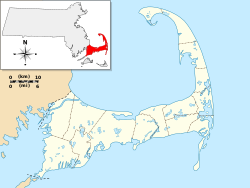Edward Penniman House and Barn | |
 Edward Penniman House | |
| Nearest city | Eastham, Massachusetts |
|---|---|
| Coordinates | 41°49′6.5″N69°57′56.4″W / 41.818472°N 69.965667°W |
| Built | 1868 |
| Architectural style | Second Empire |
| Part of | Fort Hill Rural Historic District (ID00001656) |
| NRHP reference No. | 76000155 [1] |
| Significant dates | |
| Added to NRHP | May 28, 1976 |
| Designated CP | April 5, 2001 |
The Edward Penniman House and Barn is a historic site in Eastham, Massachusetts, on Fort Hill, which is currently protected by the Cape Cod National Seashore and home to Indian Rock.
Contents
The house was built in 1868 and added to the National Register of Historic Places in 1976.

